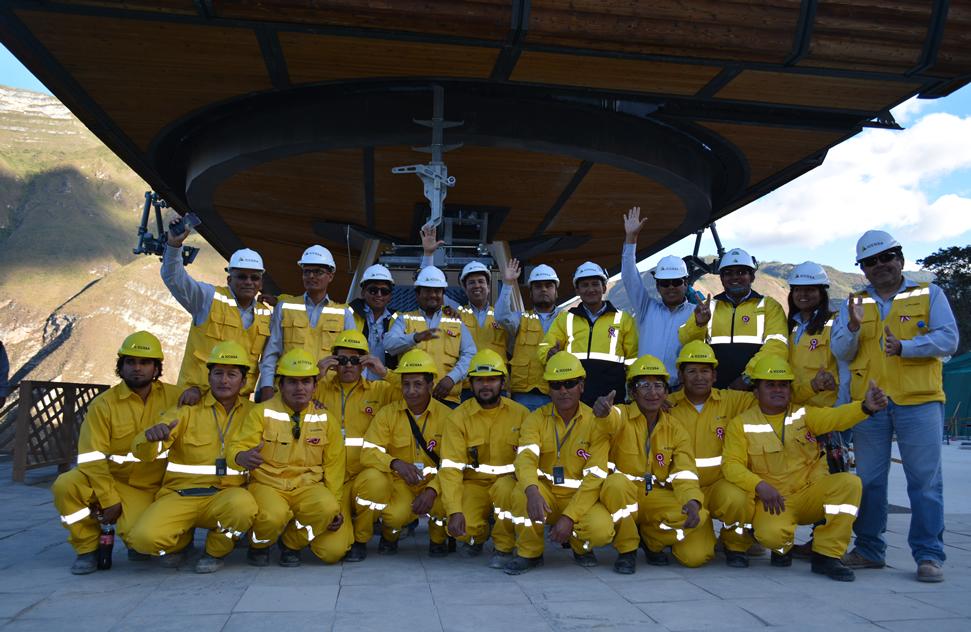News
President Ollanta Humala visits the Kuélap cable car system. It will improve the tourism in Chachapoyas
- Visitors will increase, from 40 000 to 100 000 every year, thanks to the execution of this project which has an investment of US $ 21 MM.
- The time to arrive in Kuelap fortress will be reduced from 2 hours to 20 minutes by using the cable car system.
- This high-level engineering work is possible thanks to the experience in large-scale construction projects of the Consortium Telecabinas Kuelap composed by ICCGSA – POMA.
Nuevo Tingo, July 19th, 2016.- The President of the Republic, Ollanta Humala, along with the Minister of International Trade and Tourism, Magali Silva, visited Nuevo Tingo area to inspect the progress of the Kuelap cable car system, one of the most important works for the tourist development of the country. It will become an additional alternative of access for tourists who visit the Kuelap archeological complex. This cable car system, which has an investment of US $ 21 MM, will improve the number of tourists of the fortress, from 40 thousand to 100 thousand tourists per year.
The recognized experience of ICCGSA and POMA will allow to create a cable car system which will be safe, modern, fast and comfortable. It will go over 4 kilometers in 20 minutes. The ascent will be progressive from 2 000 m.a.s.l (Exit Platform) up to 3 000 m.a.s.l (Arrival platform) showing a panoramic view of the place; an unforgettable experience for the tourist. The system is composed of 26 cabs which have a capacity of 100 passengers per hour. Each cabin can transport up to 8 passengers.
The Boarding station, located in Tingo district, 40 minutes away from Chachapoyas, has a built area of 668 m2. It is also the point of boarding for buses who carry tourists to the exit platform, throughout 3 kilometers.
In the first floor of the Boarding station, there have been built the administrative offices and a parking area for the public. In the second floor, there will be built a showroom for tourist assistance, commerce, cafeteria, waiting area, boarding area for buses to transport users to the exit platform, terraces from where people can see the valley of Tingo river and Utcubamba.
The Exit platform, with a total built area of 618.15 m2, located at 2 000 m.a.s.l; will have a basement and a first floor. In the basement, there will be a transformer room and a generating set. In the first floor, there will be the boarding and landing area for passengers, control room of the cable car system, drive station and a garage for the cable cars.
The Exit platform, with a built area of 133.3 m2, is located near to the Parador de la Malca, at 3 000 m.a.s.l. This building has a boarding and landing area; also, it has a control area of users.
The cable car system is supported on 23 line towers (bollard) of galvanized steel based on reinforced concrete foundations distributed through 4 kilometers of extension in the slopes of the Tingo river. Due to the challenges of the rugged area, the consortium identified different transport methods to provide the work with materials; it was even used a helicopter. Therefore, an additional helicopter was used for the assemblage of bollards so it could carry pieces that are part of the bollards which has a maximum weight of 6 tons. In some occasions, flights had some problems due to bad weather conditions, peculiar to the region. As a result, this work represents a high-level engineering challenge in Peru.
The assemblage required high precision works performed by qualified specialists from different nationalities. Among them, there were French, Spanish, Colombian, American, Ecuadorian and Peruvian professionals. The engineering team was composed by different specialists such as civil engineers, mechanic engineers, electromechanical engineers, and topographers with demanding skills of accuracy. The execution of the project, in its highest peak, had 320 local laborers in addition to the regular professional team.
“Implement this project, under the geographic and weather conditions peculiar to the region, has represented a great challenge. Today, we show this important progress to all the country. It could be possible by keeping our high standards of quality, safe, health and environment, without any accidents in the work”, affirmed Mr. Julio Yépez, Project Manager.
On the other hand, Jorge Ordóñez, Manager of Concessionaire Telecabinas Kuelap S.A., highlighted: “We are proud of being the first company that build the first cable car system in Peru. The results are because Telecabinas Kuelap S.A. is composed by two big companies which are leaders in their sectors: ICCGSA, a leader company in engineering and construction in huge infrastructure works and the French company POMA, leader in design, supply and instalment of cable car transport system. This synergy, reflected in the great progress so far, has a positive impact in the tourist and economic development of the Amazonas region, especially in Nuevo Tingo. Thanks to the execution of this project, we will have an additional access to the Kuelap Fortress.”
About the Consortium Telecabinas Kuélap, composed by ICCGSA and POMA.
ICCGSA is a Peruvian construction group, with 51 years in the market, dedicated to offer services of engineering, construction of huge-scale infrastructure works and road maintenance, being one of the first companies of the country.
POMA is a French company, with more than 70 years of experience worldwide. It is specialized in the cable transportation of people and materials for the industry sector. Since 1966, it has installed 300 cable car systems with disconnectable fittings, similar to the ones of Kuélap.



